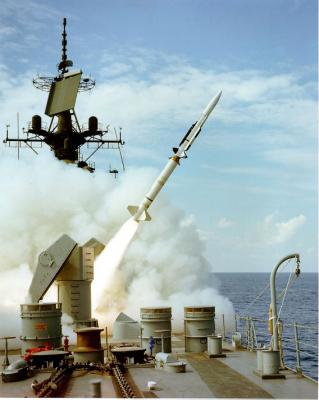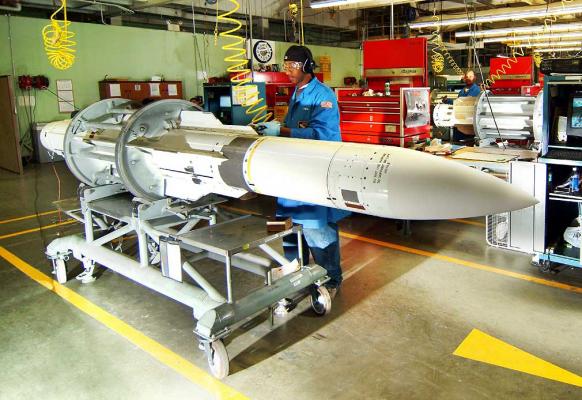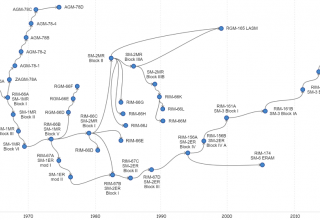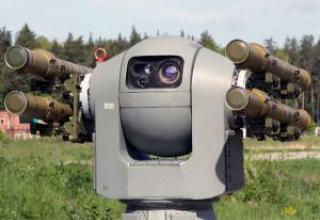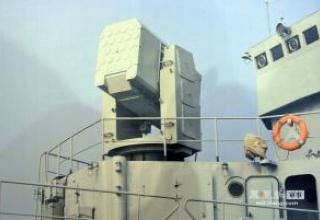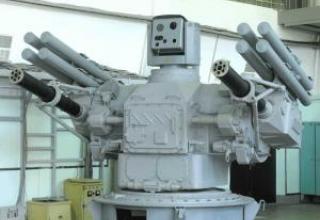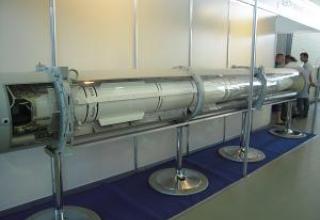In 1968, work began in the U.S. to create a promising anti-aircraft missile system Aegis, which is the main element of the ship's multifunctional combat system of the same name. For it, on the basis of Standard-1 SAM, a new generation of missiles was developed - Standard SM-2, the principal difference from the basic version was the use of a combined (command-inertial and semi-active) guidance system.
The main developer of the program is Pomona Division (General Dynamics division). In 1992, the company became part of Hughes Missile Systems, and then of the Standard Missile Company (SMCo) consortium formed by Hughes Missile Systems and Raytheon.
In 1983, the U.S. Navy was introduced in the cruiser URO Ticonderoga, equipped with missiles Standard-2. However, control firing of SAMs conducted from it at the training ground of the U.S. Navy Atlantic Fleet (area of Puerto Rico), was unsuccessful (21 launches of missiles were hit only six targets), so had to make a number of improvements relating to the radio fuse, on-board computer and its mathematical support. Tests of modified missiles, held in 1985 - 1986, were successful (100% target interception).
At present, the all-weather multifunctional ship-based combat information and control system Aegis is installed on ships of the U.S. Navy, Canada, Germany, Japan, Korea, the Netherlands, Spain, Taiwan, Australia and Denmark. The Aegis is designed to fight manned and unmanned, including winged and ballistic, air targets in difficult air conditions. The high degree of computerization and automation allows for simultaneous air defense and anti-submarine missions, as well as strikes against enemy surface ships. The system is considered one of the most advanced anti-aircraft defense systems.
Aegis uses Standard-2 Block IV (RIM-156) anti-aircraft missiles and Standard-3 (RIM-161) new generation missiles as a means of destruction. RIM-156 and RIM-161 differ from each other, primarily in their purpose. The former were designed to defeat aircraft, helicopters and cruise missiles, the latter - to destroy ballistic missiles. Currently being developed a new missile SM-6 ERAM (Extended Range Active Missile) with an extended range, which should replace SM-2. Its main advantage is a guidance system borrowed from the latest series of AIM-120 AMRAAM missiles. This system provides target acquisition outside the ship's radar range by enabling real-time target designation from remote radars.
In 2010, Lockheed Martin received a $79 million contract from the U.S. Navy to manufacture a new generation of hardware systems as part of the Aegis shipborne systems upgrade program, as well as to upgrade the Aegis Ballistic Missile Defense (BMD) single control system. In accordance with the contract, two combat control system kits to version 4.0.1, three Weapon System kits and one Multi-Mission Signal Processor (MMSP), providing simultaneous solution of missile defense and air defense tasks, are to be upgraded. The upgrade will improve the complex's performance in detecting, tracking and issuing target designation. Work with Aegis BMD - 2011, and modernization of Aegis systems on Arleigh Burke class destroyers and MMSP processor - 2012.
On July 3, 1988 the American cruiser Vincennes (CG-49) with two SM-2MR missiles shot down the Iranian civilian airliner Airbus A300B2.
Composition:
All modifications of "Standard-2" rocket are made according to normal aerodynamic scheme and have a modular design. On the middle part of the hull are attached four X-shaped wings of small elongation, almost reaching the folding aerodynamic rudders of large area in the tail of the missile. Structurally, the SAM family "Standard-2" consists of five main compartments: the head, combat unit, autopilot, engine and tail:
- In the head compartment are placed radar homing head, signal processing unit, radio detonator, on-board computer, inertial control unit and receiver radio command line communication. The head compartment is closed by a radio-transparent plastic ogival-shaped fairing.
- The compartment of the combat unit accommodates a shrapnel- or rod-type combat unit, which is detonated by a radar fuse (in several versions of missiles a contact impact fuse is also used). For safe operation, the combat unit is coupled with a safety executive mechanism with four degrees of protection.
- The autopilot compartment contains an autopilot unit, a voltage converter and an electric battery.
- The motor compartment contains a single-chamber solid fuel motor.
- In the tail compartment there is a motor nozzle and electric drives for aerodynamic steering wheel control.
The air defense guided missile "Standard-2" has a combined guidance system (radio command tele-control, inertial and semi-active radar). At flight on initial and middle sections of a trajectory the inertial system with correction by radio commands is used. If the target does not manoeuvre, the missile performs an autonomous flight using the inertial unit. In this case, it moves along the trajectory laid in the memory of its onboard computer before launch. In case of a target maneuver, the ship issues a correction command to the ZAR corresponding to the change in the current target coordinates. They are received by the onboard receiver, the antenna of which is located in the main compartment of the missile. When flying to a certain distance from the target, it is captured by the homing radar head (Homing-SLO) by receiving the reflected radar signal of the target illumination station, after which semi-active homing is performed.
The latest versions of the "Standard-2" rocket have a monopulse radar CNS, combined with an infrared homing head. This improvement significantly increased the interference immunity of the homing system and expanded the range of targets to be hit.
The "Standard-2" missile of various modifications can be used from the deck launchers Mk13 and Mk26, as well as the universal vertical launcher Mk41.
The following modifications of the "Standard-2MR" missile have been developed:
- Standard SM-2MR Block I entered the US Navy in 1977 and was produced until 1983. The missile, designed for use in the Aegis weapon system, was designated RIM-66C and RIM-66D for the Tartar system. SM-2 Block I is equipped with a 61 kg Mk90 fragmentation combat unit. It is detonated by the Mk45 radar fuse (designed to trigger not only large, but also small high-speed targets) or by a liquidator. The explosion generates up to 6000 fragments, the initial velocity of flight of which is about 2000 m/s.
- Standard SM-2MR Block II - adopted for service in 1983. The missile was equipped with an advanced Mk115 fragmentation-phase BC. The onboard guidance equipment uses digital signal processing, which increased the interference immunity of the guidance system in the conditions of the radar, including the ability to carry out passive radar self-directional guidance of the radiation source. In addition, it is equipped with a high-energy dual-mode Mk104 motor (manufactured by Thiokol), which increased the speed and range (by 60%). SM-2 Block II is used in the Aegis and Tartar systems. RIM-66G missile of SM-2MR Block II modification is designed for deck launcher Mk26 of "Aegis" system, RIM 66H of the same modification - for universal vertical launch unit Mk41 of "Aegis" system, RIM-66J - for Tartar SAM systems.
- Standard SM-2MR Block III - entered into service with the U.S. Navy in 1990. To improve the effectiveness of low-explosive anti-ship missiles are equipped with an improved Mk45 mod.8 radio detonator. At the same time, the missiles of this modification, designed for the anti-aircraft system "Tartar" also have the designation RIM-66K, the system "Aegis" with a deck mount Mk26 - RIM-66L, the system "Aegis" c HPU Mk41 - RIM-66M (see photo). The SM-2MR Block IIIA missiles received an improved MK125 combat unit to engage low-flying targets, while the SM-2MR Block IIIB is a new homing system combining a monopulse semi-active radar CNS and an infrared homing head.
The Standard-2ER (RIM-67B) two-stage long-range anti-aircraft guided missile, designed to replace the Standard-1ER (RIM-67A), was adopted by the U.S. Navy in 1984. Its first stage is a launch accelerator, and the second is based on missiles "Standard SM-2" and has all their inherent design features. In addition, it is equipped with an advanced autopilot, which provides greater stability of its flight in the middle section of the trajectory and increases maneuverability at the end, as well as the modernization of the fairing to withstand high temperatures occurring at high flight speeds (over 1000 m / s).
The following modifications of the "Standard-2ER" rocket have been developed:
- Standard SM-2ER Block I - is equipped with a marching engine Mk30 mod.2 and starting accelerator Mk12. The missile, designated RIM-67B, was intended for the Terrier system, and is currently unarmed.
- Standard SM-2ER Block II - uses an improved marching engine Mk30 mod.3 and starting accelerator Mk70, which doubled the range. It is marked with RIM-67C.
- Standard SM-2ER Block III - designated RIM-67D, equipped with an upgraded engine Mk30 mod.4 and a new radio detonator Mk45 mod.8.
- Standard SM-2ER Block IV - designated RIM-156A, has a mass of 1451.6 kg, range of fire up to 160 km, reachable height of 29000m. Increased maneuverability, improved RF and radio detonator, advanced digital signal processing provides guidance for low-flying actively maneuvering supersonic targets in conditions of intensive enemy use of REB. Designed for the Aegis system with sub-decker Vertical Launch PU.
The main control system for "Standard-2" SAM system is Aegis multifunctional system with Mk99 anti-aircraft missile control subsystem. An exception is the American Kidd type destroyers equipped with the Mk74 mod 15 control system. They have deck-mounted Mk26 mod3 PU (24 ZUR, mass of launch equipment - 89t). The same PU, but mod5 have the first five American Ticonderoga cruisers.
The main element of the Aegis system is radar AN/SPY-1A, B or D (4 flat phased antenna arrays), which functions as several conventional radars with mechanical antenna rotation. It provides automatic control of airspace with a radius of more than 190 km from the ship, detection and tracking of 250-300 targets, and pointing the most dangerous of them to 18 SAMs. The decision to hit the targets can be made automatically. The detection range of high-altitude air targets in the upper hemisphere of space is about 320 km. The main advantage of the Aegis system is the ability to combine under common control all the ship's combat systems, from multipurpose artillery and SAM systems to long-range cruise missiles. In addition, Aegis provides the possibility of collective defense, allowing you to control from one command post combat systems of the squad of ships.
Standard-2" SAM system is considered a very effective means of fighting against anti-ship missiles. According to the foreign press, the probability of destruction of one antiaircraft missile is 0.7, and two - 0.91. Therefore, according to American experts, an average of 1.3 SAMs of this type are required to intercept one such target. Therefore, in case of presence of only Standard-2 anti-aircraft missiles (122 units) in the Aegis SAM system, the ship is capable of engaging 93 to 94 PCRs of the enemy.
Characteristics:
| SM-2 MR | SM-2 ER | |
| Length, m | 4.72 | 7.98 |
| Diameter, m | 0.343 | 0.343 |
| Weight, kg | 706.7 | 1451.5 - 1507.8 |
| Weight BC, kg | 115 | 115 |
| Wingspan, m | 1.06 | 1.57 |
| Start range, km | 3-80 | 6.5-120 (170 for IV) |
| Flight height of targets, m | 15-19800 | 15-24400 |
| Rocket speed, m/s. | 1100 | 1100 |
Testing:
Among the various types of medium- and long-range anti-aircraft missiles in the arsenal of the U.S. Navy and other states, "Standard" SAMs are the most widely used. In total, the leading designers of these missiles (the U.S. companies General Dynamics and Reitheon) supplied customers (Australia, Canada, France, Germany, Iran, Israel, Italy, Japan, the Netherlands, the Republic of Korea and Spain) with about 14,000 "Standard" SAM systems of various models and modifications designed for deployment on 156 ships.
Sources:
- Зенитные ракетные комплексы ПВО СВ. Техника и вооружения №5-6.99
- SM-2 RIM-66 / RIM-67 Standard Missile
